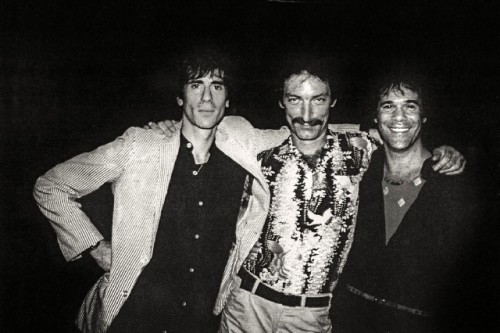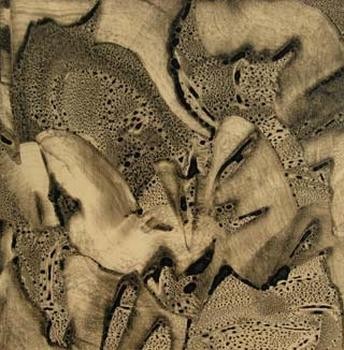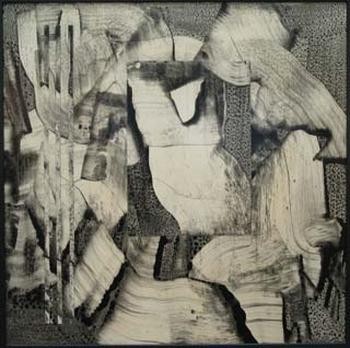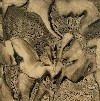Artist/ Musician Paul Shapiro
Guitarist in Boston Band Hallucinations
By: Charles Giuliano - Sep 22, 2013
While visiting Santa Fe galleries, during a recent two week tour of the South West that started and ended in Vegas, a 2,000 mile loop of spectacular scenery, we encountered landscape paintings by two former Bostonians, David Barbero and Paul Shapiro. They were older works displayed in a gallery that specializes in the secondary market. It was the first time that I had actually seen these works but I knew of them. In the case of Shapiro through a full page ad in Art in America some years back. At the time, I recalled being impressed that he had enjoyed such success since leaving Boston.
Over the years there had been talk about how Paul and David had made it big in Santa Fe. Back then, Paul they had been a founding member of the cooperative on Newbury Street, Gallery Naga, that has evolved into its current status under owner/director, Arthur Dion. Initially, I knew Paul in two separate contexts. As an exhibiting artist, I recall a party at his home in Allston and viewing a number of large, geometric, mandala like paintings. I was less familiar with him as an artist compared to his reputation as lead guitarist and founder of the legendary, 1960s, blues inflected, rock band, The Hallucinations.
When I expressed interest in the work of Shapiro the gallerist was helpful in looking up his phone number. What followed was a couple of days of phone tag. The only option was dinner on Sunday night as we were leaving the next morning. But there was one caveat as I explained to him. It was the final episode of “Desperate Housewives” and there was no way I was going to pass up the high jinks of Wysteria Lane. Indeed, Paul related that he too was a fan and a plan ensued to have dinner in time to drive to his home in suburban Santa Fe to watch the program and visit the studio.
At 5:30 there he was, promptly, at our motel door. We had just finished our daily swim and exercise. A necessity to unwind from the crimps and cramps of hours of driving and the scorching heat which ranged from the mid 90s to low 100s. As they say, a dry heat in which you don’t sweat. But a real threat to the pale skin of my red headed wife Astrid.
In the doorway we embraced before stepping back and appraising each other critically. I have put on a few pounds to be sure, and Shapiro sported a modest paunch. “How long has it been,” he asked and then answered. “Twenty three years. I moved here then and we haven’t seen each other since.” Now somewhat older he is still tall, handsome and imposing. With his big moustache and strong ethic features he looks like some Jewish, Mexican bandit from central casting. During his rock days Paul was a heart throb. In a lot of ways he still is.
Despite all those years in Santa Fe, which he discusses as a love/ hate relationship, Shapiro has not lost that Boston accent. He grew up in Winthrop in the shadow of Logan Airport the next town over from our current digs in East Boston. It was amusing to note that he still speaks out of the side of his mouth with the tone and ennui of a hipster. This is rare indeed in the art world but quite common in the genre of blue eyed soul of which he is a vintage master. It reminded me of something basically very wrong about the art world. The lack of hipsters. Mostly artists lack that acerbic edge. But I also admit to leaving the rock world behind some decades back because I had matured to the point where I wanted to have like grown up adult conversations with whole sentences and stuff. But there are things about the rock years that you really miss. The grooviness. Hanging out with Miles and Captain Beefheart. Throwing gonzo parties for Alice Cooper in my basement Cambridge apartment or going to gigs in my Nudie’s of Hollywood, orange, cowboy suit with the grilled steaks in sequins. Paul asked if I still had the suit. Yeah, but it don’t fit no more.
Over dinner, his excellent choice, Santa Fe appears to have wonderful restaurants, there as a lot of catching up. Astrid was amused and enthralled as we ran through the names and numbers. “Whatever happened to…” Or, “Have you seen…” It seemed he was really up for a bit of socializing and a stroll down memory lane. I reminded him of when he lived on the other side of a wall that partitioned the Atlantic Gallery loft of Jeff and Jane Hudson. He drove them crazy learning to play sax. “I gave that up,” he smiled and answered softly.
Just what had brought him to Santa Fe and how did he like living here I wanted to know. At the time he was residing in New Hampshire and was painting the landscape as metaphor. It surprised him to what extent this intuitive, imagined landscape resembled the actual topography he encountered when he and David Barbero first traveled to the region. He made sketches and took notes but related that he has never attempted to make a realistic landscape. Three trips ensued before the decision to relocate.
He discussed the daunting nature of the South Western landscape and how it has been the undoing of many artists. How to capture its sweep and drama? Only a few have succeeded including, most notably, the early modernists, Georgia O’Keeffe, and her friend, Marsden Hartley, or the photographer, Ansel Adams. The Santa Fe Galleries, particularly ones oriented to tourists, abound with bad examples of painting and photography that convey the all too familiar, postcard, knee jerk kitsch. Indeed this is something I will struggle with in the studio this summer as I grapple with the 80 or so rolls of film I shot during our trip. One impulse I am toying with is to give into the obvious and to generate postcard kitsch as a kind of conceptual irony. I have been thinking of a body or work to be called postcards that combine scanning actual vintage postcards, work already initiated, as well as conflating, original works in that format. This idea generates from a conversation with Montreal gallerist, Rene Blouin, when in response to some of my early taped panoramas and surreal collages, he stated that he preferred the latter to the former which were just “postcards.” I have been troubled by that remark for years and have now concluded that the truly avant-garde position will be, indeed, to violate the taboo, a mandate for progressive art, and make “postcards.” Certainly the Grand Canyon invites that.
For the first eight years of his relocation to Santa Fe Shapiro made landscapes that were enormously well received. They sold so well at rapidly rising prices that for a time he was a celebrity. “People tried to get photographed standing next to me at openings,” he recalled. He ended up buying a large house and huge studio. Since sold. The rich and famous who vacationed in Santa Fe, including film star, Jack Nicholson, bought his pictures. Life was good. Tales of his fame and fortune wafted back to the homies in Beantown.
During our evening together I was having too much fun to take notes. So I e mailed Paul with some questions and the quotes that follow are extracted from his reply.
“In 1990 I returned to abstract painting,” he wrote. “I had been making paintings that were based on the landscape of Mew Mexico and the South West area of the country. These paintings were very different from how this landscape had been depicted in the past. I created a synthesis of Fauve, German Expressionism, American modernism and abstraction. I derived a new vision of this landscape. My late friend David Barbero also did something similar. We painted together and had many discussions so it was really between the both of us that this change in how the landscape was seen came about. These landscapes were selling like crazy and many clones started to manifest. They copied either myself or Barbero and a style of landscape painting was launched. My work got really trivialized by all these hacks. History will sort this one out.”
Despite the enormous critical and financial success he enjoyed, fifteen years ago, Shapiro stopped painting landscape and returned to the abstraction that had been his primary instinct. While this represents growth and maturity in the work, and he has enjoyed critical success and sales, for the most part his former collectors did not respond to this more challenging work. At one point, when things were getting rough, his daughter urged him to go back to landscapes. He gave it a try but quickly abandoned the effort. It had become a formula that bored him. Actually it was not the first time that he had stared success in the face and walked away. Maybe it’s the hipster Lenny Bruce/ Pancho Villa thing. To thrive as a bandit and outlaw. Like Groucho getting admitted to that club he reviled. Or Brando not attending the Oscars but sending up a Native American woman to accept his award. Success undermines your street cred. The true hipster has to raise the bar. Play the long shot. Or, as Machiavelli put it, “Flatterers should be shunned.”
It would seem that Shapiro straddles two worlds: Art and music. Just how did that happen for a tough kid with a horrendous family life growing up in Winthrop? How do you get from the burbs to the delta? Along the way there was a side trip to Northeastern University where he majored in biology and organic chemistry. Across the street from the university was what was then notorious as “coffee corner” a hangout for beat poets, musicians and hipsters. Presided over by such legendary figures as Joe Kerr, or “The Joker,” Al “The Arab” Hamway, Bill “Total Gonzo” Cardoso. It was here that, “I ran into Arthur Yanoff who was studying painting at the School of the Museum of Fine Arts. We had grown up together and I wanted to see what he was doing. We visited the school and I had this experience of alignment and instantly know I had to be a painter. I left Northeastern that day and enrolled in night school the following semester. I made that decision in October, 1958 and attended the Museum School from 1959-1962. I left because I was the only abstract painter in the whole school at the time.”
Parallel to the cathartic and intuitive discovery of art was an older and deeper passion for music. He started playing guitar and harmonica at the age of thirteen. “I was pre Elvis and smelled a racial rat when covers of blues and R&B tunes were becoming hits by these white wimps like Pat Boone. I had band fantasies when the groups started coming out of England. I was running a frame shop for the Child’s Gallery on Newbury Street from 1962-65 and met Steve Bladd who was framing for Boris Mirski’s Bunnell Frame Shop. (Boris’s son, Mark, a regular of Coffee Corner, was known to his peers as “Bonnie Prince Junkie.”) That was around 1964 and we would talk a lot about music. At some point he mentioned that he would like to play the drums. I encouraged him to buy a set and we could jam together. I don’t know how he did it but he could play drums as soon as he bought them. At some point he mentioned that he had a friend who played guitar named Doug Slade. We met at a party in Brookline Village to play unrehearsed. While we were playing a guy asked if he could sit in and sing. We were doing Sonny Boy Williamson’s ‘One Way Out’ and he pulled out a harmonica and we were off and running. I said, ‘Let’s form a real band.’ That was Peter Wolf’s debut. We invited a bass player Joe Clark and Steve Bladd came up with the name Hallucinations. The band lasted from October 1965 through June 1969. We did gigs with Muddy Waters, Howlin Wolf, John Lee Hooker and numerous well known sixties groups. I left in the summer of 1969 because of some ridiculous identity crisis. Am I a painter or a musician? Of course, now I am a painter who plays music and feel wonderful about it. The band morphed into the J. Geils Band with Peter Wolf and Steve Bladd. The rest is rock and roll history. Sometimes I feel like the Fifth Beatle, Pete Best. None of that would have happened if I didn’t put The Hallucinations together because I was Peter’s mentor and turned him on to a lot of the music.”
I vividly recall hearing performances of The Hallucinations at the Boston Tea Party. Their girlfriends used to sit on stage propped up against the speakers. That was so cool. My sister was a real fan. Years later she just froze when at a social event I said, “Pip, this is Peter, and Peter, this is Pip.” It was one of those great moments when a big brother does something way cool for a little sis. Peter and Magic Dick, the band’s harmonica player, were my neighbors in the Murder Building in Harvard Square. Used to run into them at Cardell’s cafeteria between gigs. That’s when Peter started dating Faye Dunaway “The Lady Makes Demands” after Edie died.
When The Hallucinations broke up they were the hot band in Boston which was beginning to make some noise in the national music scene after the fiasco of Mike Curb and MGM’s Bossound. Remember Ultimate Spinach, The Remains, Thirteenth Floor Elevator, The Bagatelles, The Charles River Valley Boys, Molty the Hook and the Barbarians? J Geils would go on to be one of the leading American bands of its generation. What might have been? So there is some irony that Shapiro became a celebrity painter, however fleetingly. Perhaps the music he was making was becoming too formulaic. He was getting locked into that rock star groove. Time to woodshed like Sonny Rollins before “The Bridge.”
To reinvent himself. Like the great artists. “What about Picasso,” he asked me rhetorically. “He changed, so why can’t I?” But the art market can be fickle. They like you to make the same stuff over and over. Like Peter Max. Or Roy Lichtenstein. How boring. No. The Myth of Sisyphus is the model of the true artist. Pushing that boulder up the mountain only to have it tumble down again and start over and over and over. Always pushing uphill. No rest. Just the exquisite pain. The inspiring and all important angst. Pushing buttons and pissing people off.
In that sense Shapiro is a true artist. How I love him. What a mensch. Like Gorky. He wears his suffering so well like notches on the gun belt of Billy the Kid. But each kill actually a self inflicted wound.
On this particular evening he was warm, funny, richly anecdotal, nostalgic, vulnerable and melancholy. Recently, Christine, his sixth wife
of the past seven years, has relocated to rural France. She wants him to join her there and Paul is conflicted about the decision. While he has mixed feelings about the theme park, tacky, tourist aspects of Santa Fe he also describes it as the only place in America where he can live. This summer he may visit France but isn’t thinking much beyond that.
We toured his enormous house and studio. The second floor, now emptied of her furniture and possessions. It has a separate kitchen and bathroom and he is contemplating renting the space. Or, selling the house and…?
By most standards the studio is huge but he says that he has to “Make do” after downsizing from a much larger space. It was cluttered with works stacked against walls, or in boxes. There is even more work in storage that he rents. You sense that he is enormously prolific. Works seven days a week when not playing the National Steel guitars propped up on stands. At one point he played a couple of tunes from a recent session. “Sound’s like Son House but that’s me actually on guitar and harmonica. I am playing my best music right now.” But pure blues not the rock of The Hallucinations which perhaps had begun to bore him back in the day. Indeed I would like to hear more of the music.
And see more of the work. What we saw was riveting. After the landscapes he had explored aspects of calligraphy and collage. He showed us a few examples of that work. But there was an epiphany a year and a half ago on New Year’s Day that led to a body of small, abstract works on paper, strongly resembling in surface and texture, photogravures about which he is guarded, secretive and even mystical. He refuses to describe the technique and discusses the imagery as inspired by Quantum Mechanics. “I connected to things that I have been reading about. “The Field” by Lynne McTaggart and pondering. I made something that is very ethereal/ concrete. This work poured out of me. I tapped into something and could not stop it.” Only a handful of his closest friends have seen the series. A major Santa Fe dealer has expressed interest but nothing has been confirmed. Actually, this feels more like East Coast, New York work. I am urging him to let me show it in Boston where it would have a proper audience.
The discussion of this new work was so broad that I asked him by e mail to give me an artist statement. “I can’t seem to make an official artist statement about this work yet,” he wrote. “I feel that this work is beyond the verbal and exists in a realm that is beyond art history, culture, etc. It seems to be related to a deep meditative state that is outside our normal experience as though I am peeking behind the fabric of consensual reality and having entered into a visual metaphor where the physical building blocks of many realities exist waiting to be interacted with thus creating subject and object. That is why I think that there is a connection with my work and quantum physics. Of course my work is a metaphor of this and not an actual depiction of something that can’t be depicted anyway because it is outside of the realm of the usual senses. Maybe I just made an artist’s statement.”
That’s ok man, don’t worry about it. I won’t blow your cover. Later. An update: As of November, 2005, Shapiro was in the process of selling his home in Santa Fe with plans to relocate to Berlin where a daughter lives.
-----





